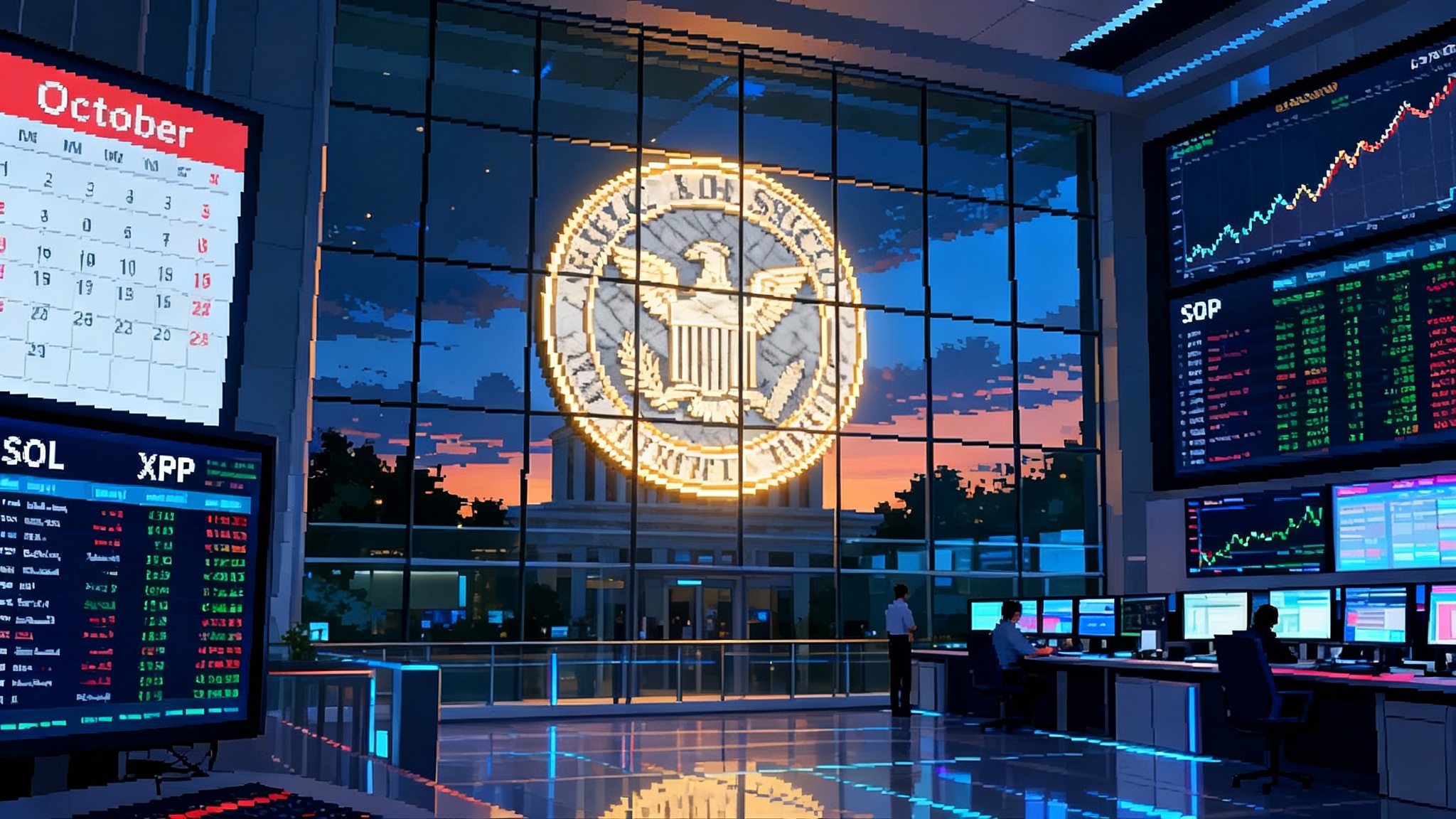SEC’s new ETF rules put Solana and XRP ETFs within reach
The SEC just adopted generic listing standards for spot commodity ETPs, replacing case-by-case approvals. That shift can fast track Solana and XRP ETFs, shorten launch timelines, and reward issuers ready to move now.

What changed and why it matters
On September 18, 2025, the SEC approved exchange rules that allow generic listing of spot commodity exchange traded products, including crypto asset commodities. Instead of each product needing a bespoke rule change, compliant funds can list once they satisfy a standardized checklist. See the Commission’s thinking in Commissioner Hester Peirce’s SEC generic listing standards.
Why it matters: for years, sponsors faced two hurdles. First, an exchange had to win a rule change under Exchange Act Section 19(b). Second, the issuer’s registration statement had to be cleared under the Securities Act. The new approach removes the custom 19(b) step when a fund fits the generic template, which compresses timelines and reduces subjective roadblocks. Reuters highlights the shorter pathway and expected timing in its Reuters timeline impact.
For background on how spot crypto funds work in practice, see our Bitcoin spot ETF guide and the Ether ETF timeline.
A faster lane for non BTC, non ETH spot ETFs
Multiple exchanges can now list qualifying crypto commodity ETPs without a custom filing. In practice, the path from idea to launch can shrink from many months to a few, provided the issuer’s registration statement becomes effective. First movers are targeting October listings under the new framework.
The upshot: Solana and XRP now have a realistic near term pathway after Bitcoin and Ether.
Why Solana and XRP are suddenly in frame
Under the generic standards, exchanges can show market integrity through objective routes. Two are especially relevant for crypto:
- A futures contract on the same asset has traded for at least six months on a CFTC regulated designated contract market.
- The exchange has adequate surveillance arrangements tied to a regulated market of significant size for that asset.
Solana and XRP both now have regulated U.S. futures on CME. That gives exchanges a rules based bridge from on exchange spot ETP trading to a regulated derivatives venue.
- Solana futures began trading in March 2025. The six month mark arrived in mid September, which means Solana ETFs can use the futures criterion immediately if offering documents are ready.
- XRP futures began trading in May 2025. The six month clock points to late November, which nudges most XRP spot ETF launches into late Q4 if issuers rely on the six month futures prong.
A second, less discussed path exists. If an exchange listed ETF already provides at least 40 percent exposure to a given commodity, a new ETP referencing the same commodity could qualify under the generic standards. In crypto, that 40 percent anchor is more likely after the first single asset fund launches.
The hurdles that still matter
Generic standards lower barriers, but they do not erase requirements. Three issues remain decisive.
1) Commodity versus security status
- The framework explicitly references crypto asset commodities. In practice, exchanges will lean on the existence of CFTC regulated futures and the Commission’s willingness to treat the token as a commodity for ETP purposes, similar to Bitcoin and Ether.
- XRP’s litigation history left a split record. Programmatic sales on exchanges were not investment contracts, while certain institutional sales were. For ETF mechanics, the key is that creations and redemptions do not reintroduce characteristics of a securities offering by the token’s issuer. Sponsors have mirrored trust structures that worked for Bitcoin and Ether.
- For Solana, the SEC has previously signaled it could be a security in some contexts. The presence of U.S. regulated futures plus the generic standards gives exchanges a defensible argument that SOL qualifies as a commodity for listing, though issuers will still disclose legal uncertainty.
Bottom line: the debate will not be settled by ETP approval alone, but CME futures plus the generic template reduces prior friction points.
2) Surveillance sharing and reference markets
- Under the old model, crypto spot ETPs hinged on surveillance sharing with a regulated market of significant size tied to the spot price. For Bitcoin and Ether, CME futures satisfied that link. The generic standards formalize alternatives and clarify that CFTC regulated futures with sufficient trading history can serve as the surveillance nexus.
- Expect exchanges to pair CME data with cross market tools and the Intermarket Surveillance Group framework for equities, options, and futures. Even if major U.S. crypto spot exchanges are not ISG members, anchoring surveillance to CME and demonstrating cross venue manipulation detection can meet the standard. For an explainer, see surveillance sharing basics.
3) Custody, creations, and market structure
- Qualified custody: U.S. trust companies with SOC audited controls will serve as custodians. Cold storage, multi sig controls, strict key management, and sizable insurance will mirror Bitcoin and Ether ETPs.
- In kind versus cash: Sponsors are likely to repeat the successful Bitcoin playbook with in kind creations and redemptions to minimize tracking error and reduce large cash conversions at the open.
- No staking or yield: As with Ether spot ETFs, do not expect staking or protocol yield inside the fund. The vehicle remains a price tracking commodity ETP.
- Corporate actions and protocol events: Prospectuses will describe how they handle forks, airdrops, network halts, and valuation during disruptions. Solana’s history of occasional congestion means clear NAV playbooks for disruption scenarios.
Winners and losers in the next 90 days
Near term winners
- First mover Solana issuers: Sponsors with mature filings and authorized participant networks can credibly hit October or early November for SOL. Early assets compound the lead.
- Listing venues with crypto depth: Cboe BZX and NYSE Arca are positioned to host the initial wave, including options listings and data revenues.
- CME Group: Futures and options on Solana and XRP give authorized participants and hedge funds tools to hedge inventory, tighten spreads, and warehouse risk.
- Large APs and market makers: Firms with cross venue connectivity, borrow lines, and basis hedging experience in BTC and ETH ETFs can extend those muscles to SOL and XRP.
Potential losers or pressured segments
- Late to file issuers: First mover advantage still dominates in ETFs. Laggards will struggle for shelf space and marketing mindshare.
- On chain DEX liquidity at the margin: A low fee, brokerage native ETF can soak up some retail demand, pulling spot volumes from CEXs and DEXs into the ETP wrapper. After launch, a rising asset base can lift on chain activity.
- Tokens without regulated futures: The template rewards assets with a CFTC regulated derivatives market. Names without that anchor may be deprioritized.
A catalyst calendar through Q4 2025
- Late September: Exchanges publish notices and operational bulletins for Solana products with effective or near final registration statements. Issuers finalize AP agreements and seed capital.
- Early to mid October: If staff comments are minimal, first Solana spot ETFs can go effective and list. Options market makers ready risk models for day one activity. Marketing pivots from education to allocation.
- Mid to late October: Legacy 19(b) deadlines for earlier Solana filings arrive, but many sponsors rely on the generic pathway instead. Liquidity builds as platforms complete due diligence.
- Late November to December: XRP’s six month futures milestone opens the expedited path. If registration statements are ready, first XRP spot ETF listings can cluster in late Q4. CME options on Solana and XRP add hedging depth around the same time.
Practical note: even with generic listing, the gating factor is the Securities Act registration statement. Issuers that have iterated with staff since spring or summer are best positioned to clear quickly. Newcomers likely slide into Q1 2026.
What builders and investors should do now
For ecosystem builders on Solana and XRP
- Package enterprise grade access: Expect more institutions to ask for compliant custody, throttled endpoints, and SOC audited service layers. Productize those pathways to reduce integration friction.
- Prepare for liquidity shifts: If short term on chain volume dips when ETFs go live, curate higher signal liquidity and deepen books on pairs institutions will use. Improve market data quality for gateway partners.
- Double down on reliability: Network resilience becomes part of investability. Publish incident response plans, post mortems, and client facing uptime SLAs.
For ETF sponsors and trading partners
- Build a borrow stack: Identify lenders willing to extend SOL and XRP inventory so creations and redemptions can be managed without widening spreads. Hedge residuals with CME futures and options as they scale.
- In kind precision: Rehearse end of day baskets and NAV calculation in stress scenarios. Solana throughput spikes and XRP cross border flows can produce price gaps, so have contingency playbooks.
- Messaging discipline: Speak plainly about what the fund is and is not. No staking. No active management. Focus on tight tracking, low fees, and robust controls. That is what unlocks platform approval lists.
For investors
- Watch liquidity, not just fees: In early weeks, the tightest spreads and deepest secondary volume can matter more than a few basis points of fee difference.
- Sequence matters: Solana likely lists before XRP due to the six month futures criterion. If you intend to hold both, plan entries accordingly rather than chase simultaneous launches.
- Use futures intelligently: Sophisticated investors can pre hedge allocations with CME futures, then roll into ETF shares after launch to reduce timing risk. Understand basis and roll costs.
What could still derail near term launches
- A last minute CorpFin snag: If disclosures on custody, valuation, or risk fall short, the registration statement will not go effective.
- A market integrity headline: Major manipulation or custody incidents can slow staff comfort even under generic standards.
- Unexpected policy shifts: The Commission can still tighten interpretations if it perceives investor risk, especially for tokens with less transparent markets.
The bottom line
With generic listing standards now in place, the U.S. has moved from bespoke approvals to a repeatable playbook for spot crypto ETFs. Solana sits in the fast lane for an October to early November debut given its six month futures runway. XRP likely follows later in Q4 once its six month mark arrives, assuming filings are polished.
Winners will be prepared issuers and exchanges, plus APs and market makers with borrow lines and basis hedges ready. Losers will be late movers and assets without a regulated derivatives backbone.
For builders and investors, treat ETFs as capital infrastructure. Make participation easy, safe, and boring for large allocators, and mainstream demand can do the rest.








